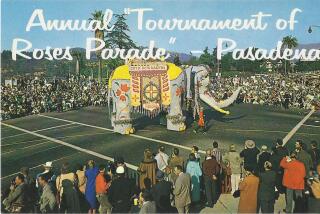Hats Off to Strawberries : The Fields Have Shrunk but Garden Grove Festival Grows
- Share via
Much has changed since the first Garden Grove Strawberry Festival in 1959, when parade grand marshal Francis X. Bushman, the star of silent films, led a meager line of antique cars through city streets and 10 carnival rides were set up on a small plot at the corner of Brookhurst Street and Brookhurst Way.
In the 30 years since, Garden Grove has grown from about 85,000 residents to more than 133,000, and the celebrated strawberry fields that once lined Katella Avenue and carpeted other parts of town have dwindled to 78 acres.
But despite the decline of the strawberry, the festival has grown steadily from its modest beginnings. This year’s event, opening Friday, offers 40 carnival rides, more than 100 food, game and commercial booths and exhibits and a televised parade featuring dozens of celebrities. Up to 250,000 people are expected to attend the four-day festival, billed as the second-largest community-sponsored event in the West, behind the Rose Parade.
Jack Wallin, the only remaining member of the original festival board, has watched the changes first hand. “We didn’t really know what we were doing” in the beginning, Wallin said.
The festival lost money its first two years, but since then, he said, “we’ve been able to keep ahead of it pretty well.”
In fact, the festival has turned into a money machine for local civic and nonprofit groups. Last year’s festival, for instance, turned an $80,000 profit that was returned to the community. Among the beneficiaries: the Garden Grove Symphony, which was given a new $19,000 grand piano, and the Senior Meals on Wheels program, which received a $19,000 truck.
The festival funds scholarships and also has pledged $100,000 toward restoration of the Mills House, a civic art gallery.
Local groups also raise money themselves by running food and game booths at the festival.
“We’ve done so much for the city,” Wallin said. “It’s brought people so close together in the community. I don’t think you’ll find a city that works so hard” on a community event.
The festival did have some rough years in 1968-71, when events were marred by violent clashes between youths and police. The entire festival was almost a casualty of the riots and was eventually shortened from five to four days, with a ban on rock music.
“We had a couple of really bad years,” said Wallin, who blamed the general unrest of the times. “We haven’t had any trouble since then.”
Festival president Larry Shaffer, on the nonprofit festival board for 10 years, has seen changes even during his tenure. Five years ago, the parade was turned over to a professional producer, which helped head off such recurring problems as late starts. “It’s a heck of a lot more professional than when we used to do it ourselves,” Shaffer admitted, laughing.
And, since 1986, the parade has been broadcast on commercial TV. This year, it will be shown live on KHJ-TV Channel 9, with hosts Sally Struthers and Tristan Rogers.
There have been some carry-overs from the first festival, such as a huge strawberry shortcake that is carved up and served to visitors (this year’s cake, billed as the world’s largest, will serve 4,000 people) and a “Redhead Roundup,” in which prizes are awarded for the reddest hair and the most freckles.
Overall though, the festival--and the city--have changed a lot since 1959. “It was just a little celebration then,” said Shaffer, who has lived in Garden Grove since 1954.
“It was a very small town 30 years ago. . . . The city has changed a lot.”
More to Read
Sign up for The Wild
We’ll help you find the best places to hike, bike and run, as well as the perfect silent spots for meditation and yoga.
You may occasionally receive promotional content from the Los Angeles Times.






